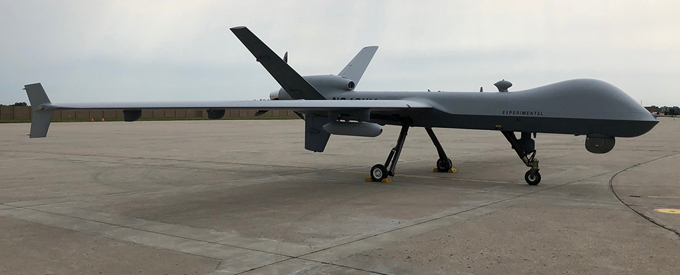2020-10-18
New Pods Add More Teeth to GA-ASI’s MQ-9
The international partnership between General Atomics Aeronautical Systems Inc. (GA-ASI) and the engineering and technology firm SENER since 2008 has resulted in significant agreements regarding the MQ-9A Remotely Piloted Aircraft (RPA) for Spain and its adaptation to the requirements of the Spanish Armed Forces. The latest joint development effort is a NATO Pod, designed and built by SENER Aeroespacial, part of the SENER Group. GA-ASI will integrate the NATO Pod onto the MQ-9 aircraft line to increase its configuration and payload options.
NATO Pod development is driven by GA-ASI’s initiative to provide customers with a customisable pod for carriage of sovereign, cross-domain Intelligence, Surveillance and Reconnaissance (ISR) sensors that can be integrated onto GA-ASI-built MQ-9A and MQ-9B RPA Systems. GA-ASI is working with European suppliers to add sensor capabilities to the new European-built payload pod that meets NATO airworthiness standards.
The NATO Pod is a flexible, scalable, certifiable, aerodynamic and low-cost enclosure that enables customers to add sovereign sensor capabilities developed in their respective countries using a common set of interfaces to the aircraft system. This approach reduces integration time and cost.
“With the NATO Pod, European sensor suppliers will be provided a standard Size, Weight and Power (SWAP) and Interface Control Document (ICD) to the aircraft system to efficiently integrate their payloads. This offers our customers a broader range of ISR capabilities and makes ISR-system upgrades faster,” said Linden Blue, CEO, GA-ASI. “Interface standardisation also allows sovereign containment of payload hardware and data by customers, when required.”
Andrés Sendagorta, president of the SENER Group, highlighted: “Since the beginning in 2008, the relationship between GA-ASI and SENER has been based on the existence of a common corporate philosophy where the technological component represents a fundamental link. This has led to an alliance in which the development of value-added products and technology by SENER has been applied to meet the demanding needs of GA-ASI over the years and, particularly, now with the NATO Pod that will be integrated onto the MQ-9 line. As we have stated on previous occasions, and once the first system of this type has come into operation in Spain, SENER reiterates its commitment to make available to the Spanish Ministry of Defense its capabilities and strengths in support of national industry through alliances, industrial cooperation and the development of an increasingly wide range of products.”
Having recently successfully completed the system definition and specification phase, the conceptual and preliminary design phases, as well as the Critical Design Review, SENER Aeroespacial is currently working for GA-ASI on the detailed design phase of the NATO Pod. The firm is designing the NATO Pod from the ground up to be certifiable having established a wide set of certification base requirements that will fulfil the vast majority of demands from European certification agencies.
Expanding AI Capabilities
Recently GA-ASI, with the support of SRC Inc., successfully integrated and flew the U.S. Air Force Research Laboratory’s (AFRL) Agile Condor Pod on an MQ-9 RPA at GA-ASI’s Flight Test and Training Center in Grand Forks, North Dakota, U.S. The Agile Condor Pod provides on-board high-speed computer processing coupled with machine learning algorithms to detect, correlate, identify, and track targets of interest. With this capability, the MQ-9 is able to identify objects autonomously utilising its on-board Electro-optical/Infrared (EO/IR) sensor and GA-ASI’s Lynx Synthetic Aperture Radar (SAR).
GA-ASI President David R. Alexander said: “GA-ASI is committed to expanding artificial intelligence (AI) capabilities on unmanned systems and the Agile Condor capability is proof positive that we can accurately and effectively shorten the observe, orient, decide and act cycle to achieve information superiority. GA-ASI is excited to continue working with AFRL to advance AI technologies that will lead to increased autonomous mission capabilities.”
High-powered computing at the edge enables autonomous target detection, identification and nomination at extended ranges and on-board processing reduces communication bandwidth requirements to share target information with other platforms. This is an important step towards greater automation, autonomous target detection, and rapid decision-making. In a statement, GA-ASI has said that it will continue to work with AFRL to refine the capability and foster its transition to operational constructs that will improve warfighters’ ability to operate in contested or denied environments.


No Comments